1. Rajdhani Express
The Rajdhani Express is a series of passenger train service in India operated by Indian  Railways connecting the national capital New Delhi with the capitals or largest city of various states. This series of trains regularly gets the highest priority in the Indian Railways network and is considered as its most premium train. The word Rajdhani means Capital in many languages as spoken in India. hey are fully air-conditioned. Their Maximum speed is 130kmph. Passengers are served optional meals (food price included in the train fare) during the journey. Currently there are 24 pairs of trains, connecting New Delhi to important cities across the country. Indian Railways started to upgrade Rajdhani Coaches to Tejas coaches. These trains are called the Tejas-Rajdhani Express. All Rajdhani Express trains offer three classes of accommodation: AC First Class (1A) with 2-berth and 4-berth coupès (with locking facility for privacy), AC 2-tier (2T) with open bays (4 berths/bay + 2 berths on the other side of the aisle of each bay), provided with curtains for privacy, and AC 3-tier (3T) with open bays (6 berths/bay + 2 berths on the other side of the aisle of each bay) without curtains. The fastest Rajdhani is Mumbai Central New Delhi Tejas Rajdhani Express (12951/12952) with and average speed of 90kmph.
Railways connecting the national capital New Delhi with the capitals or largest city of various states. This series of trains regularly gets the highest priority in the Indian Railways network and is considered as its most premium train. The word Rajdhani means Capital in many languages as spoken in India. hey are fully air-conditioned. Their Maximum speed is 130kmph. Passengers are served optional meals (food price included in the train fare) during the journey. Currently there are 24 pairs of trains, connecting New Delhi to important cities across the country. Indian Railways started to upgrade Rajdhani Coaches to Tejas coaches. These trains are called the Tejas-Rajdhani Express. All Rajdhani Express trains offer three classes of accommodation: AC First Class (1A) with 2-berth and 4-berth coupès (with locking facility for privacy), AC 2-tier (2T) with open bays (4 berths/bay + 2 berths on the other side of the aisle of each bay), provided with curtains for privacy, and AC 3-tier (3T) with open bays (6 berths/bay + 2 berths on the other side of the aisle of each bay) without curtains. The fastest Rajdhani is Mumbai Central New Delhi Tejas Rajdhani Express (12951/12952) with and average speed of 90kmph.


2. Shatabdi Express
Shatabdi Express trains are a series of fast passenger trains operated by Indian  Railways to connect Metro cities with other Major cities for tourism, pilgrimage & business purposes. Shatabdi Express are day-trains and they return to the station of origin the same day. Along with Rajdhani Expresses, Shatabdi Expresses get the highest priority on the routes they ply in. The Shatabdi Express trains run over short to medium distance routes. Shatabdi Expresses have a Maximum permissible speed of 130 km/h with the exception of 12001 Bhopal Shatabdi (the fastest Shatabdi) which runs at a maximum permissible speed of 150 km/h. The name "Shatabdi" means centenary in Sanskrit. The first Shatabdi Express train was introduced on 10 July 1988 (Bhopal Habibganj New Delhi Shatabdi). All of them have AC Chair Car. Most of the Shatabdi Express trains have, however, one or two coaches of Executive Class seating. Recently, Indian Railways have started offering Anubhuti Class seating also in some of them and some of them have Vistadome coach seating with about whole part transparent roof. Indian Railways operates 23 pairs of Shatabdi Express as of October 2019.
Railways to connect Metro cities with other Major cities for tourism, pilgrimage & business purposes. Shatabdi Express are day-trains and they return to the station of origin the same day. Along with Rajdhani Expresses, Shatabdi Expresses get the highest priority on the routes they ply in. The Shatabdi Express trains run over short to medium distance routes. Shatabdi Expresses have a Maximum permissible speed of 130 km/h with the exception of 12001 Bhopal Shatabdi (the fastest Shatabdi) which runs at a maximum permissible speed of 150 km/h. The name "Shatabdi" means centenary in Sanskrit. The first Shatabdi Express train was introduced on 10 July 1988 (Bhopal Habibganj New Delhi Shatabdi). All of them have AC Chair Car. Most of the Shatabdi Express trains have, however, one or two coaches of Executive Class seating. Recently, Indian Railways have started offering Anubhuti Class seating also in some of them and some of them have Vistadome coach seating with about whole part transparent roof. Indian Railways operates 23 pairs of Shatabdi Express as of October 2019.

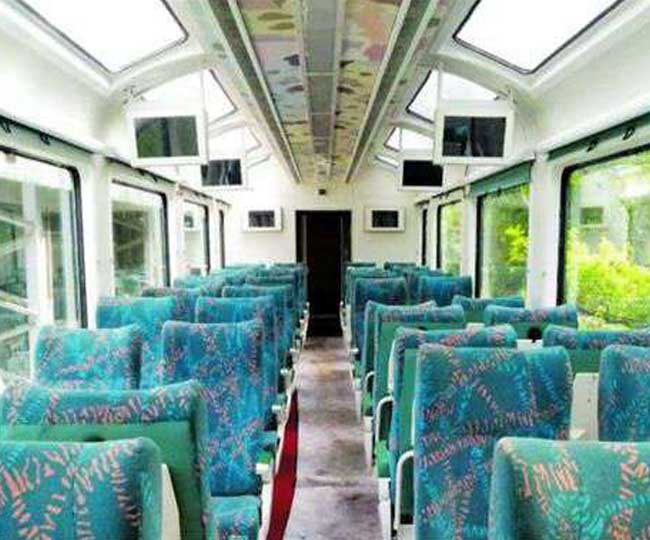

3. Duronto Express
Duronto Express is a category of long-distance non-stop source to 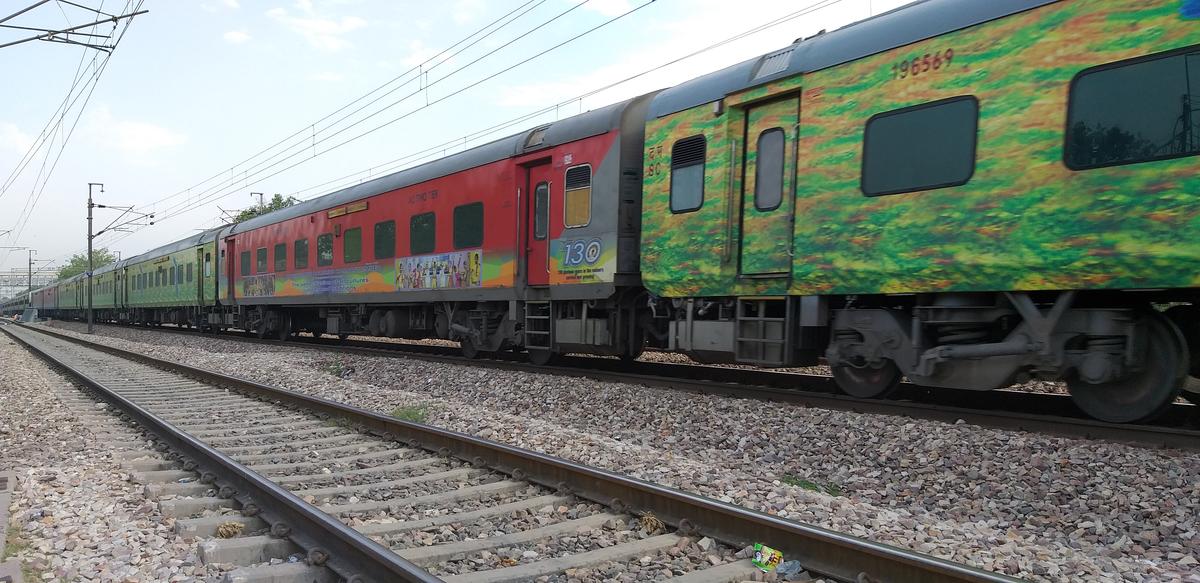 destination trains run by the Indian Railways. Initially these trains did not have any ticketing stops between the origin and the destination, but since January 2016 it is possible to book tickets from those technical stops. "Duronto" means "Speedster" in Bengali. As of now, there are currently 24 pairs that are working. The trains will adhere to the speed limit of 130 km/h. New Delhi–Sealdah Duronto Express has a top speed of 130 km/h. The Chennai, Sealdah, Yeshwantpur and Pune Duronto runs at a speed of 130 km/h. Secunderabad Hazrat Nizamuddin, with Hybrid-LHB rakes is the only Duronto permitted to run at a speed of 120 km/h. A feature exclusive to the Duronto is the LHB Sleeper coach. The sleeper class is the most common coach, and usually ten or more coaches can be attached.
destination trains run by the Indian Railways. Initially these trains did not have any ticketing stops between the origin and the destination, but since January 2016 it is possible to book tickets from those technical stops. "Duronto" means "Speedster" in Bengali. As of now, there are currently 24 pairs that are working. The trains will adhere to the speed limit of 130 km/h. New Delhi–Sealdah Duronto Express has a top speed of 130 km/h. The Chennai, Sealdah, Yeshwantpur and Pune Duronto runs at a speed of 130 km/h. Secunderabad Hazrat Nizamuddin, with Hybrid-LHB rakes is the only Duronto permitted to run at a speed of 120 km/h. A feature exclusive to the Duronto is the LHB Sleeper coach. The sleeper class is the most common coach, and usually ten or more coaches can be attached.


4. Humsafar Express
Humsafar Express is a fully premium service 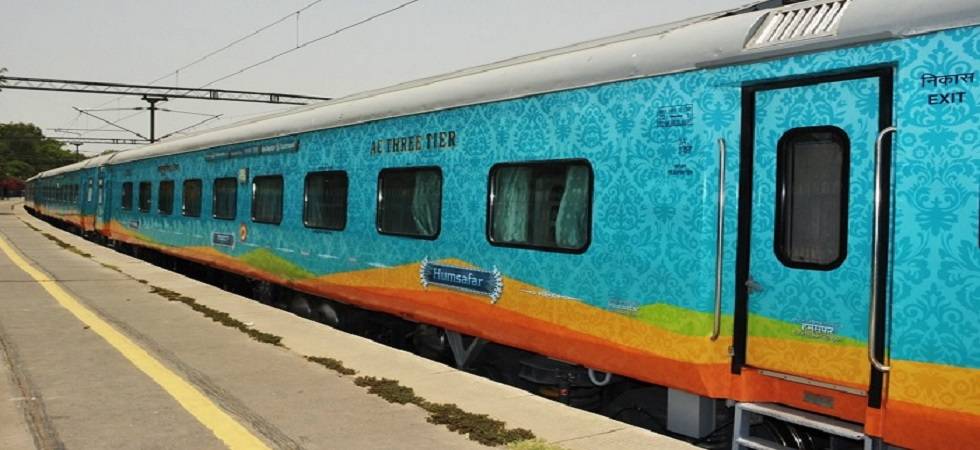 with AC-3 Tier and Sleeper class accommodation having all the modern facilities designed and operated by Indian Railways. "Humsafar" is a Urdu word meaning "life partner" or "soulmate" The first service was inaugurated on 16 December 2016 between Gorakhpur and Anand Vihar Terminal, New Delhi. There are currently 39 sets of Humsafar fleets. The fares of Humsafar Express at the time of launch are around 15–20% higher compared to normal AC-3 tier and Sleeper class fares. Reading lights for each passenger, more comfortable berths than the previous 3-tier AC sleeper rakes, each compartment has Bio-toilets, Vending machines are installed for tea, coffee and milk etc. are some of the features in this train
with AC-3 Tier and Sleeper class accommodation having all the modern facilities designed and operated by Indian Railways. "Humsafar" is a Urdu word meaning "life partner" or "soulmate" The first service was inaugurated on 16 December 2016 between Gorakhpur and Anand Vihar Terminal, New Delhi. There are currently 39 sets of Humsafar fleets. The fares of Humsafar Express at the time of launch are around 15–20% higher compared to normal AC-3 tier and Sleeper class fares. Reading lights for each passenger, more comfortable berths than the previous 3-tier AC sleeper rakes, each compartment has Bio-toilets, Vending machines are installed for tea, coffee and milk etc. are some of the features in this train

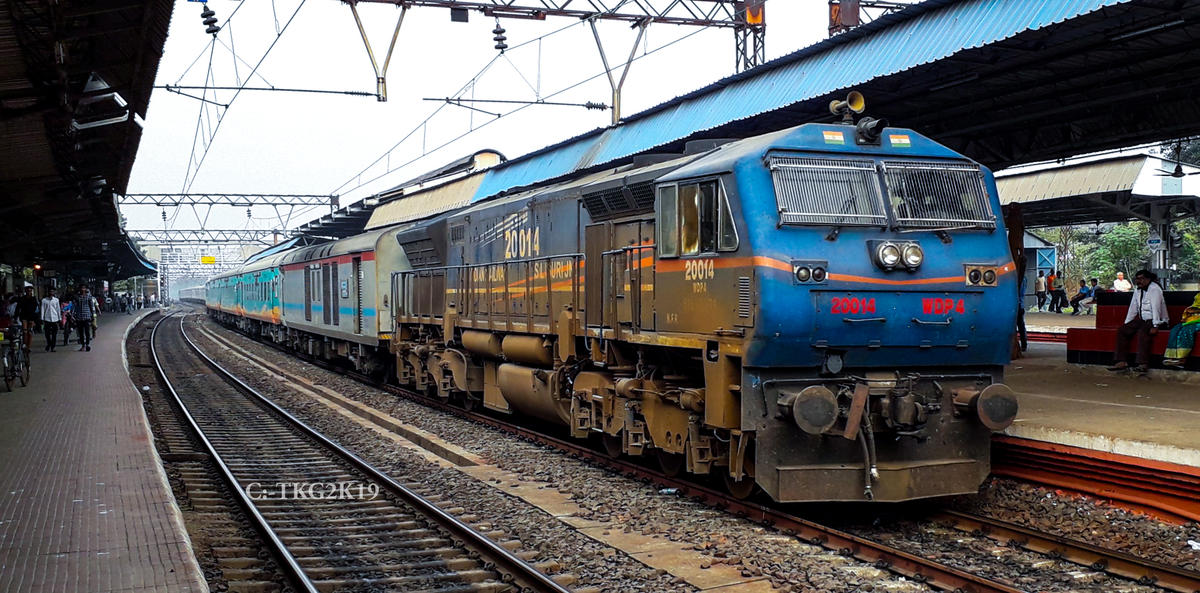

5. Garib Rath Epress
The Garib Rath is a no-frills air-conditioned train started by the Indian Railways in 2005 to provide subsidized price air-conditioned long-distance travel to passengers who could not afford standard fares of air-conditioned class in regular-fare trains. As the fares are less than two-thirds of the fares for air-conditioned classes in other trains, the distance between each seat or berth is less, the seats and berths are narrower and each coach has more seats and berths than in air-conditioned coaches in other trains. Only seating and three-tier (78 seats) accommodation is provided in these trains. The passengers are not provided with free bedding or food. It is significantly faster and has higher priority than Superfast Express trains. The maximum speed of Garib Rath trains is 130 km/h which is at par with Rajdhanis and Duronto. The maiden journey of the train started from Saharsa, Bihar to Amritsar, Punjab.



6. Double Decker Express
On Indian Railways, Double Decker Express trains are express  trains composed of bi-level passenger seating rail carriages. They have high priority and are considered among fast trains in India. This type of trains was introduced on short travel routes and to cater more people than a conventional chair car carriage. This also allowed the passengers to plan last-minute journeys with confirmed reservations. The Howrah–Dhanbad AC Double Decker Express was the first of its type to be introduced. Currently, new era of Double Decker Express trains are introduced in Indian Railways which is named as Uday Express (Utkrisht Double Decker AC Yatri). Currently, two Uday Express trains are in service. The first one is Bangalore City–Coimbatore Uday Express and the second is Visakhapatnam–Vijayawada Uday Express. There are onlt two non AC double deckers in India - The lying Ranee Epress and the Mumbai Valsad passenger. Rest all are fully air conditioned.
trains composed of bi-level passenger seating rail carriages. They have high priority and are considered among fast trains in India. This type of trains was introduced on short travel routes and to cater more people than a conventional chair car carriage. This also allowed the passengers to plan last-minute journeys with confirmed reservations. The Howrah–Dhanbad AC Double Decker Express was the first of its type to be introduced. Currently, new era of Double Decker Express trains are introduced in Indian Railways which is named as Uday Express (Utkrisht Double Decker AC Yatri). Currently, two Uday Express trains are in service. The first one is Bangalore City–Coimbatore Uday Express and the second is Visakhapatnam–Vijayawada Uday Express. There are onlt two non AC double deckers in India - The lying Ranee Epress and the Mumbai Valsad passenger. Rest all are fully air conditioned.



7. Tejas Express
The Tejas Express is a semi-high speed fully air-conditioned train  introduced by Indian Railways. It features modern onboard facilities with doors which are operated automatically. Tejas means "sharp", "lustre", or "brilliance" in many Indian languages. It is one of 3 semi-high speed trains running in India, the others being the Vande Bharat Express and the Gatimaan Express. The inaugural run of Tejas Express was on 24 May 2017 from Mumbai Chhatrapati Shivaji Maharaj Terminus to Karmali, Goa. Coaches have bio-vacuum toilets, water level indicators, tap sensors, hand dryers, integrated braille displays, LED TV for each passenger with phone sockets, local cuisine, celebrity chef menu, WiFi, tea & coffee vending machines, magazines, snack tables, CCTV cameras, fire & smoke detection and suppression system. The fares will be 20% to 30% more than Shatabdi fares. Doors are centrally controlled.
introduced by Indian Railways. It features modern onboard facilities with doors which are operated automatically. Tejas means "sharp", "lustre", or "brilliance" in many Indian languages. It is one of 3 semi-high speed trains running in India, the others being the Vande Bharat Express and the Gatimaan Express. The inaugural run of Tejas Express was on 24 May 2017 from Mumbai Chhatrapati Shivaji Maharaj Terminus to Karmali, Goa. Coaches have bio-vacuum toilets, water level indicators, tap sensors, hand dryers, integrated braille displays, LED TV for each passenger with phone sockets, local cuisine, celebrity chef menu, WiFi, tea & coffee vending machines, magazines, snack tables, CCTV cameras, fire & smoke detection and suppression system. The fares will be 20% to 30% more than Shatabdi fares. Doors are centrally controlled.



8. Jan Shatabdi
The Jan Shatabdi Express is a more affordable and economical 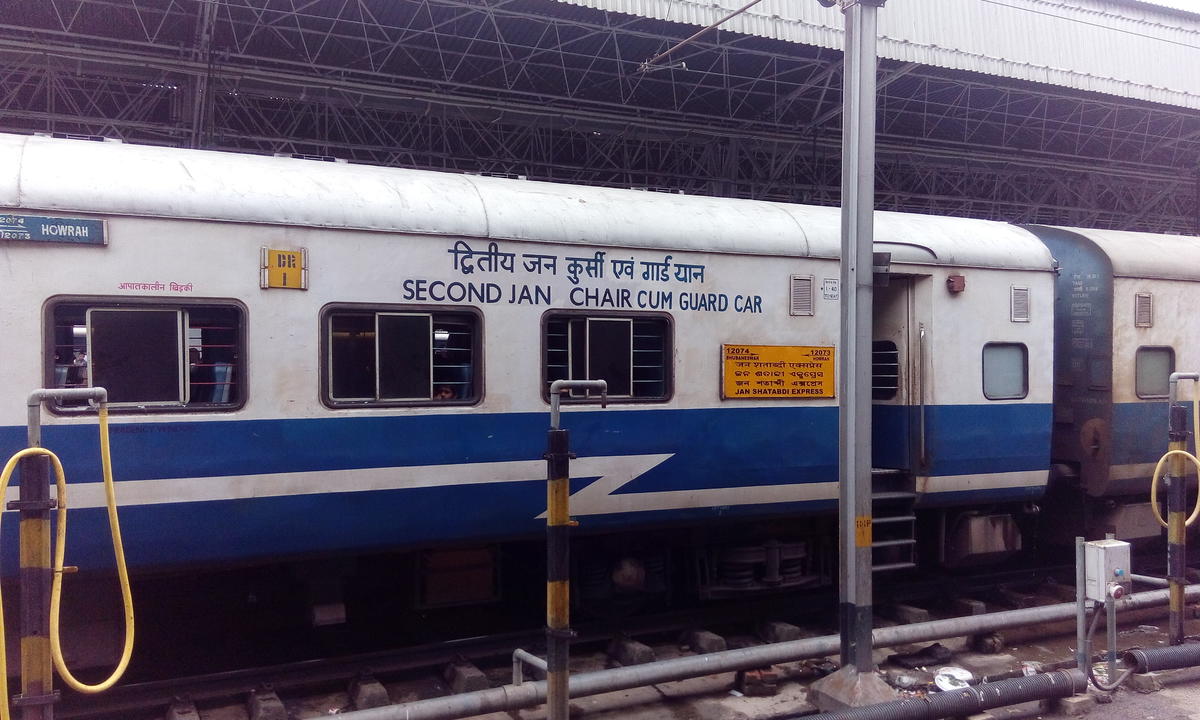 version of the Shatabdi Express. The word 'Jan' refers to common people. Being an economical version of the Shatabdi Express, it provides the passenger with Air Conditioned Chair Car, Second Class Seating and Unreserved classes. Though its priority is less than that of the trains like Rajdhani Express, Shatabdi Express and Duronto Express, but its enjoys a greater priority than the Mail, Express and the Superfast Express trains of Indian Railways. The maximum permissible speed of this train is 130 km/hr.
version of the Shatabdi Express. The word 'Jan' refers to common people. Being an economical version of the Shatabdi Express, it provides the passenger with Air Conditioned Chair Car, Second Class Seating and Unreserved classes. Though its priority is less than that of the trains like Rajdhani Express, Shatabdi Express and Duronto Express, but its enjoys a greater priority than the Mail, Express and the Superfast Express trains of Indian Railways. The maximum permissible speed of this train is 130 km/hr.



9. Vande Bharat Express/Train 18
The Vande Bharat Express, also known as Train 18,  is an Indian semi-high-speed, intercity, EMU train which is operated by the Indian Railways only on two prominent routes as of March 2022, one from New Delhi (NDLS) to Shri Mata Vaishno Devi Katra (SVDK) and the other from New Delhi (NDLS) to Varanasi (BSB). It was designed and manufactured by Integral Coach Factory (ICF) at Perambur, Chennai under the Indian government's Make in India initiative, over a span of 18 months. Vande Bharat Express is designed to be capable of running at a maximum speed of 160 kmph that can be touched in only 140 seconds for commercial purpose and it exceeded 180kmph during testing, but the tracks on which the train operates are not capable of supporting such high speeds, hence the train is operated at a maximum speed of 130 km/h (81 mph) The train flagged off for an inaugural run by Prime Minister of India Narendra Modi, on 15 February 2019, with its commercial run started from 17 February 2019 onwards. The Vande Bharat Express's exterior appearance consists of aerodynamic design, narrowing at each end of the train which is designed to combat air resistance.[27] It also has a driver cabin at each end, allowing for faster turnaround at terminating stations.[28] The train has 16 passenger cars, with a seating capacity of 1,128 passengers.[29] Two of the center compartments are first class compartments that seat 52 each, with the rest being coach compartments seating 78 each.
is an Indian semi-high-speed, intercity, EMU train which is operated by the Indian Railways only on two prominent routes as of March 2022, one from New Delhi (NDLS) to Shri Mata Vaishno Devi Katra (SVDK) and the other from New Delhi (NDLS) to Varanasi (BSB). It was designed and manufactured by Integral Coach Factory (ICF) at Perambur, Chennai under the Indian government's Make in India initiative, over a span of 18 months. Vande Bharat Express is designed to be capable of running at a maximum speed of 160 kmph that can be touched in only 140 seconds for commercial purpose and it exceeded 180kmph during testing, but the tracks on which the train operates are not capable of supporting such high speeds, hence the train is operated at a maximum speed of 130 km/h (81 mph) The train flagged off for an inaugural run by Prime Minister of India Narendra Modi, on 15 February 2019, with its commercial run started from 17 February 2019 onwards. The Vande Bharat Express's exterior appearance consists of aerodynamic design, narrowing at each end of the train which is designed to combat air resistance.[27] It also has a driver cabin at each end, allowing for faster turnaround at terminating stations.[28] The train has 16 passenger cars, with a seating capacity of 1,128 passengers.[29] Two of the center compartments are first class compartments that seat 52 each, with the rest being coach compartments seating 78 each.



10. Gatiman Express
The 12049 / 12050 Gatimaan Express is India's first semi-high speed train that runs between Delhi and Jhansi.[3][4][5][6] It takes 265 minutes (around 4.5 hours) to cover the 403 km (250 mi) journey from Hazrat Nizamuddin to Virangana Lakshmibai Junction railway stations with an average speed of 91 km/h (57 mph).[7] The top operating speed of the Gatimaan Express is up to 160 km/h, which makes it the fastest regularly scheduled train service in India. The train was launched on 5 April 2016 and completed its maiden journey between Nizamuddin and Agra Cantt within 100 minutes.[9][10] But due to low occupancy, Indian Railways first extended this train from Agra to Gwalior on 19 February 2018 and then to Virangana Lakshmibai junction on 1 April 2018

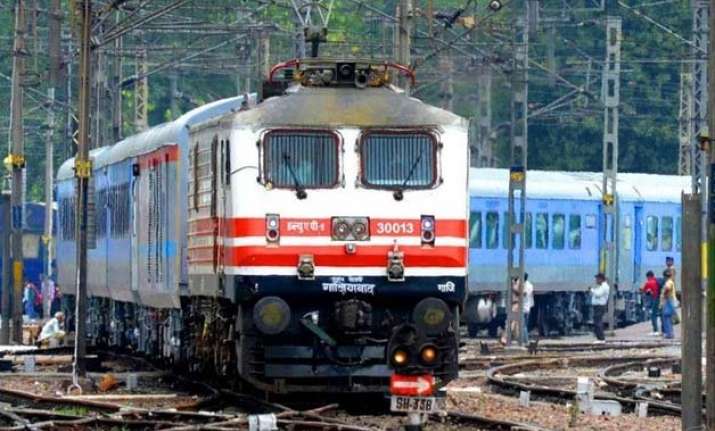

11. Mahmana Express
Mahamana Express is a Model Rake based superfast express series trains operated by Indian Railways in India. This train is named after and in honor to Pt. Shri Madan Mohan Malaviya (Mahamana), a freedom fighter & an educationist who established Banaras Hindu University, Varanasi. There are 6 pairs of Mahamana express in India. The coaches contain some modern facilities like - Toilet: Bigger mirror, platform wash basin, controlled discharged water tap, odour control system, exhaust fans, LED lights, dustbin inside the toilet, All the toilets are fitted with bio toilets, in line with Indian Railways' vision to make tracks defecation free. Lighting: LED based berth indicators for reserved coaches, and all other illumination. Safety: Fire extinguishers in all coaches, etc
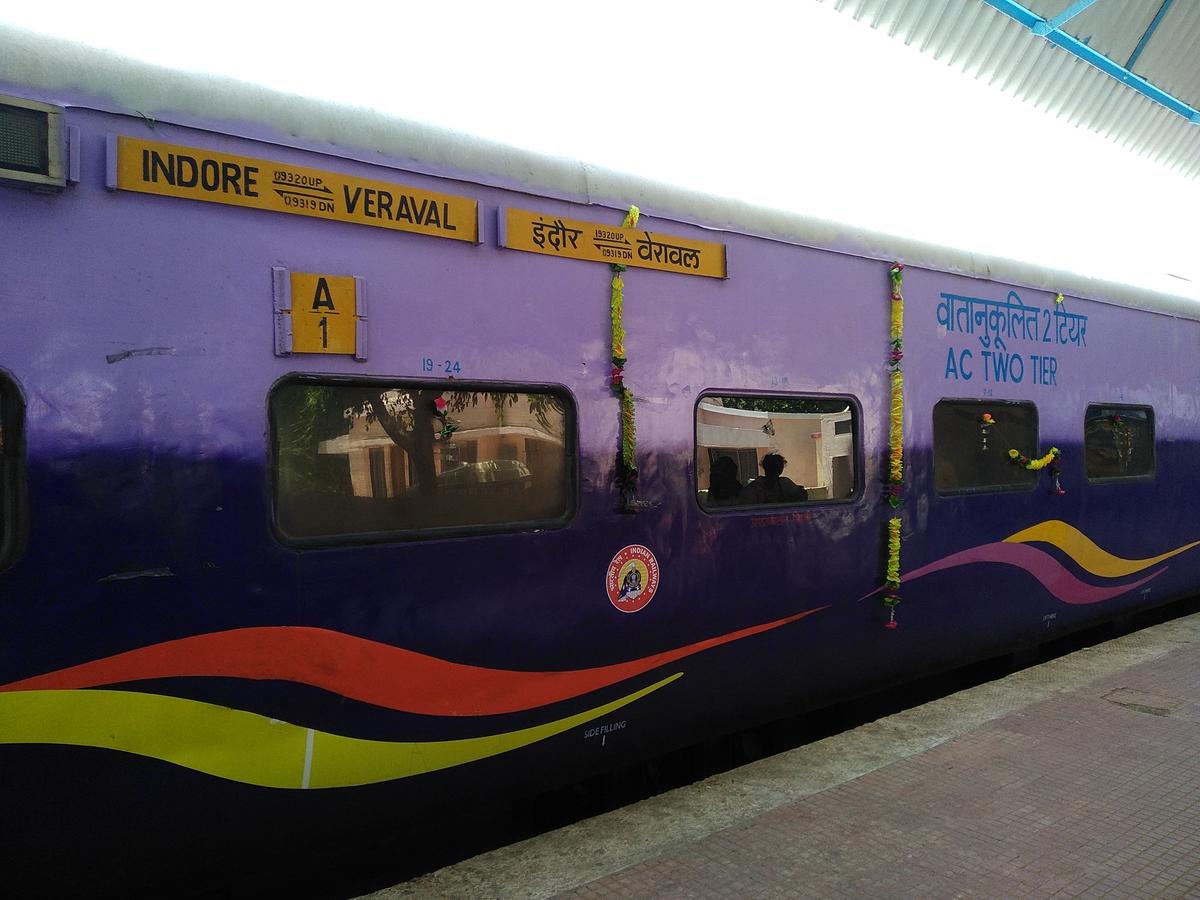

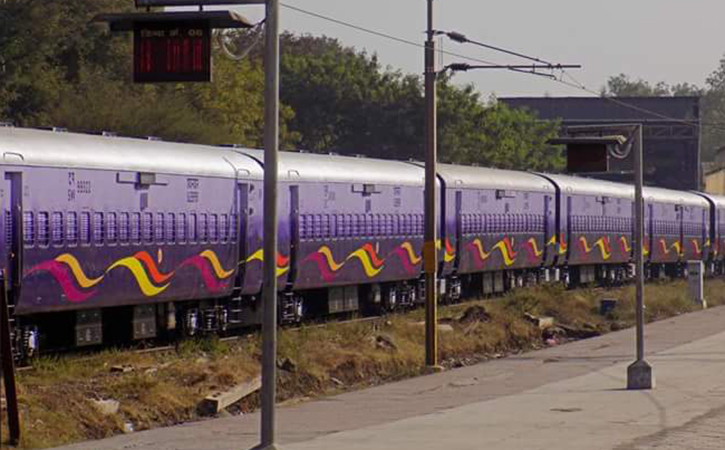
12. Antyodaya Express
Antyodaya Express are series of trains operated by Indian Railways. The word Antyodaya refers to the uplifting of the weakest section of the society. These series of trains are initially supposed to be overnight fully unreserved trains but later on converted into typical overnight express train with reservation system. Antyodaya Express was proposed in 2016 Railway budget of India to operate on peak routes having more rush. coaches are designed by Indian Railways with state-of-the-art bio-toilets and facility for mobile charging in compartments as well. The first generation of this series is jan sadharan express. Some of the jan sadharan trains are converted to antyodya express trains. The first service of Antyodaya Express was started on 27 Feb 2017, between Ernakulam Junction and Howrah inaugurated by Suresh Prabhu, the former Minister for Railways.

13. Yuva Express
The Yuva Express[1] series of trains were introduced by erstwhile Minister of Railways Mamata Banerjee during the 2009-10 budget together with the Duronto Express. They were intended to provide an air-conditioned low-cost travel option for the youth of the country. During the budget, two trains between Howrah & Mumbai were chosen. It was initially intended to run as a point to point service however commercial stops were soon introduced on the service. Sixty percent seats of the train are reserved for students, low-income groups & people belonging to the age group of 18 - 45yrs. Earlier there were only AC chair car coaches but later it was augmented by AC 2 Tier and AC 3 Tier coaches as well. There were 2 Yuva Express - Bandra Anand Vihar Terminus and Howrah Anand Vihar Terminus. The Howrah Anand Vihar Turminus Yuva Express has been discontinued


14. Sampark Kranti Express
Sampark Kranti Express trains are a series of  Superfast express trains operated by the Indian Railways providing quick connectivity to the national capital, New Delhi or Chandigarh. The words Sampark and Kranti are borrowed from Sanskrit. Sampark means Contact and Kranti means Revolution. The combined name denotes the steps taken by Indian Railways to provide high speed train connections from cities around India with the National Capital through the provision of non-air conditioned express trains with few stops and operating at high speeds. The Sampark Kranti trains operate at slower average speeds than the Rajdhani and Shatabdi series yet still provide high speed options at normal prices due to their few stops and relatively faster speeds compared with other express trains. The Railway Minister (India) at the time Nitish Kumar in the interim Railway Budget of 2004-05 announced the launch of Sampark Kranti Express. The trains in the Sampark Kranti series connect the Indian states to the national capital city of New Delhi. Sampark Kranti trains charge the same fare as regular/superfast trains on the Indian Railways rail network and do not provide any special facilities not available in regular Express trains. The initial decision of non-stop run of this Express series of trains was cut short and was given way to commercial stopping outside the states.[2] The trains aim at reducing travel time without compromising on passenger comfort. The Karnataka Sampark Kranti Express from Delhi Hazrat Nizamuddin to Yesvantpur was the first train which was launched on 8 February 2004. Currently there are 23 Sampark Kranti Express in India
Superfast express trains operated by the Indian Railways providing quick connectivity to the national capital, New Delhi or Chandigarh. The words Sampark and Kranti are borrowed from Sanskrit. Sampark means Contact and Kranti means Revolution. The combined name denotes the steps taken by Indian Railways to provide high speed train connections from cities around India with the National Capital through the provision of non-air conditioned express trains with few stops and operating at high speeds. The Sampark Kranti trains operate at slower average speeds than the Rajdhani and Shatabdi series yet still provide high speed options at normal prices due to their few stops and relatively faster speeds compared with other express trains. The Railway Minister (India) at the time Nitish Kumar in the interim Railway Budget of 2004-05 announced the launch of Sampark Kranti Express. The trains in the Sampark Kranti series connect the Indian states to the national capital city of New Delhi. Sampark Kranti trains charge the same fare as regular/superfast trains on the Indian Railways rail network and do not provide any special facilities not available in regular Express trains. The initial decision of non-stop run of this Express series of trains was cut short and was given way to commercial stopping outside the states.[2] The trains aim at reducing travel time without compromising on passenger comfort. The Karnataka Sampark Kranti Express from Delhi Hazrat Nizamuddin to Yesvantpur was the first train which was launched on 8 February 2004. Currently there are 23 Sampark Kranti Express in India


15. Local trains
Suburban/local trains plays a major role in the public transport system of many major Indian cities. These services are operated by Indian Railways. Suburban rail is a rail service between a central business district and the suburbs, a conurbation or other locations that draw large numbers of people daily. The suburban rail systems in Hyderabad, Pune, Lucknow–Kanpur and Bengaluru do not have dedicated suburban tracks but share tracks with long-distance trains. The suburban rail system of Mumbai, Kolkata and Chennai have both dedicated tracks and tracks shared with long-distance trains. The first suburban rail system in India is Mumbai Suburban Railway which started operations in 1853. The Kolkata Suburban Railway has the largest network in the entire country. Suburban trains that handle commuter traffic are all electric multiple units (EMUs). They usually have nine or twelve coaches, sometimes even fifteen to handle rush hour traffic. One unit of an EMU train consists of one power car and two general coaches. Thus a nine coach EMU is made up of three units having one power car at each end and one at the middle. The rakes in the suburban rails run on 25 kV AC. In some cities of India, the opening of rapid transit systems has led to a decline in the use of the suburban rail system. MEMU mainline elecric multiple units and DEMU (diesel electric multiple units) are also used in suburban rail


16. AC Express
AC Express trains are fully air-conditioned  Superfast Express trains linking major cities in India. They have high priority but is less than Rajdhani, Duronto and Shatabdi and are among the fastest trains in India. Though some trains travel at 130 km/h at some sections, most of them are restricted to a speed of 110 km/h. The food is not free in these trains but the bedroll is free for passengers who are traveling by AC Express. The charges of these trains are cheaper than Rajdhani Express, Duronto Express and Humsafar Express also. Some of the AC Express trains have pantry cars for required passengers. The first AC train Nanda Devi AC Express ran on 1 July 2008 with the maximum speed of 125 kmph. Sir M. Visvesvaraya Terminal–Kamakhya AC Superfast Express is the longest running AC Superfast Express of Indian Railways covering total distance of around 3025 kilometres. There are 31 pairs of AC express
Superfast Express trains linking major cities in India. They have high priority but is less than Rajdhani, Duronto and Shatabdi and are among the fastest trains in India. Though some trains travel at 130 km/h at some sections, most of them are restricted to a speed of 110 km/h. The food is not free in these trains but the bedroll is free for passengers who are traveling by AC Express. The charges of these trains are cheaper than Rajdhani Express, Duronto Express and Humsafar Express also. Some of the AC Express trains have pantry cars for required passengers. The first AC train Nanda Devi AC Express ran on 1 July 2008 with the maximum speed of 125 kmph. Sir M. Visvesvaraya Terminal–Kamakhya AC Superfast Express is the longest running AC Superfast Express of Indian Railways covering total distance of around 3025 kilometres. There are 31 pairs of AC express


17. Express
An express train is one where the average speed, excluding halts,  is greater than 42 km/h. Including halts the average speed often is below 42 km/h. Although this is pretty slow as compared to international standards, the "Express" trains here mean faster than the ordinary passenger and local trains. They have more stops than Rajdhani, Shatabdi but less that local trains or passenger trains. They have Unreserved, Sleeper coaches, sitting coaches, AC Chair Car, AC 3 tier, Ac 2 tier 1st class AC
is greater than 42 km/h. Including halts the average speed often is below 42 km/h. Although this is pretty slow as compared to international standards, the "Express" trains here mean faster than the ordinary passenger and local trains. They have more stops than Rajdhani, Shatabdi but less that local trains or passenger trains. They have Unreserved, Sleeper coaches, sitting coaches, AC Chair Car, AC 3 tier, Ac 2 tier 1st class AC
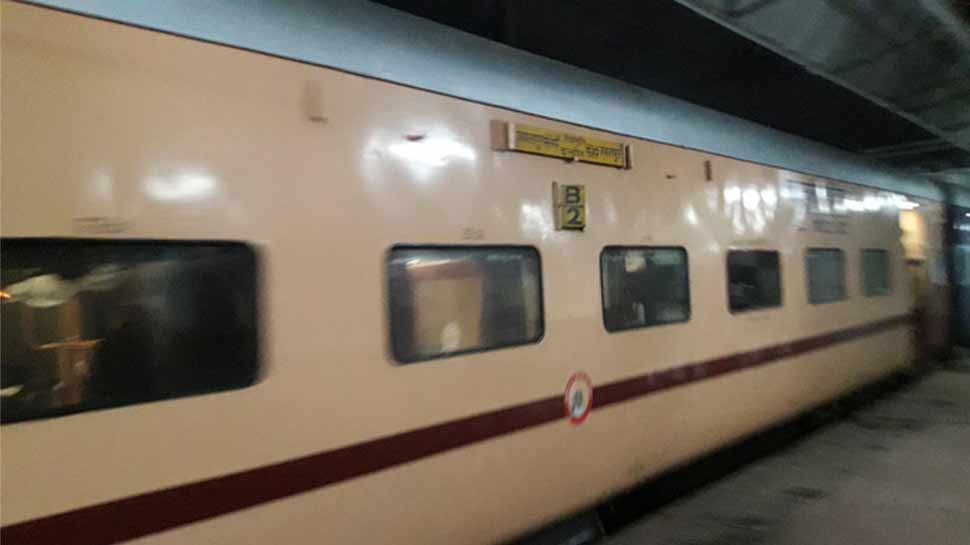


18. Superfast Express
Superfast trains are express trains which make still  fewer stops, as compared to ordinary express trains, achieving still shorter journey times. Tickets cost more than ordinary express trains as they have "superfast surcharge" added to them. Trains with an average speed, excluding halts, equaling or exceeding 55 kilometres per hour (34 mph) (60 kilometres per hour (37 mph) until the early 1990s) on both up and down journeys fall into this category and are numbered with a prefix of 12 or 22 or 20 (previously 2). Including halts the average speed often is below 55 km/h. In some cases, trains run superfast where there is an overlapping express service available, and run as ordinary express trains where there is no supplementary express service. They have Unreserved, Sleeper coaches, sitting coaches, AC Chair Car, AC 3 tier, Ac 2 tier 1st class AC
fewer stops, as compared to ordinary express trains, achieving still shorter journey times. Tickets cost more than ordinary express trains as they have "superfast surcharge" added to them. Trains with an average speed, excluding halts, equaling or exceeding 55 kilometres per hour (34 mph) (60 kilometres per hour (37 mph) until the early 1990s) on both up and down journeys fall into this category and are numbered with a prefix of 12 or 22 or 20 (previously 2). Including halts the average speed often is below 55 km/h. In some cases, trains run superfast where there is an overlapping express service available, and run as ordinary express trains where there is no supplementary express service. They have Unreserved, Sleeper coaches, sitting coaches, AC Chair Car, AC 3 tier, Ac 2 tier 1st class AC

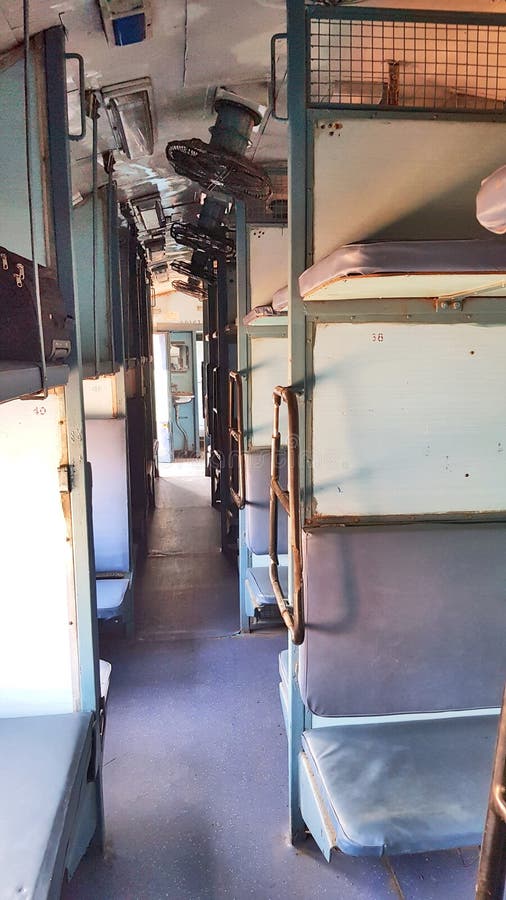

19. Jan Sadharan Express
Jan Sadharan Express trains are series of passenger services operated by Indian Railways in different routes. These trains are the first generation of fully unreserved express train sets. The second generation is the antyodya express. an Sadharan Express trains are fully unreserved trains thereby providing cheaper transport aimed at common people. The services were first announced during the Interim Rail budget on 30 January 2004. There are 7 Jan Sadharan Express. The other trains have been converted to Antyodaya Express



20. Suvidha Superfast Express
The Suvidha Express also called as Premium Express[1] series of trains were introduced by Indian Railways in 2014 for the 1st time which is operated in busiest routes. They were intended to follow dynamic pricing in fares. Priority of Premium trains are above Superfast and Mail/Express trains. Priority of Premium trains are above Superfast and Mail/Express trains[6] like Shatabdi Express, Duronto Express and Rajdhani Express. As similar to the other trains of Indian Railways, these trains also have five digits. Only change is that, the first digit is 8.



21. State Express
State Express connects a state capital or an important city in the state to the NCT - New Delhi. They have Unreserved, Sleeper coaches, sitting coaches, AC Chair Car, AC 3 tier, Ac 2 tier 1st class AC. Their priority is less than Rajdhani Shatabdi Trains and have many halts.

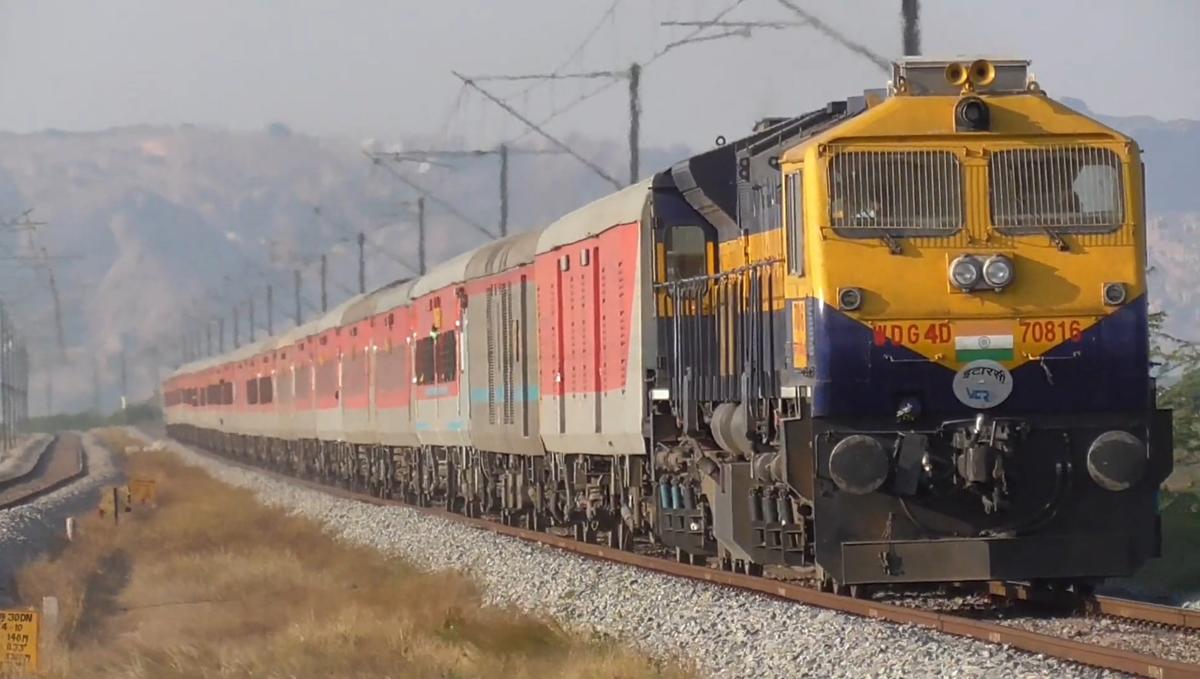

22. Golden Chariot
The Golden Chariot is a luxury tourist train that  connects the important tourist spots in the Indian states of Karnataka, Goa, Kerala & Tamil Nadu as well as Pondicherry, depending on the selected itinerary. It is named after the Stone Chariot in the Vitthala Temple at Hampi.[1] The 19 coaches on the train are coloured purple and gold, and sport the logo of a mythological animal with the head of an elephant and a body of a lion.[2] The Golden Chariot had its maiden commercial run on 10 March 2008,[3] and generally runs weekly during the months of October–March, departing on Sundays during the 2022-23 season.[4] The train, along with the Deccan Odyssey, is designed on the lines of the more popular Palace on Wheels with accommodations, spa treatments and dining. It has been awarded the title of "Asia's Leading Luxury Train" at World Travel Awards, 2013[5] The train is operated by the Karnataka State Tourism Development Corporation. The Golden Chariot offers accommodation in 44 cabins in 11 coaches that are named after dynasties that ruled the region: Kadamba, Hoysala, Rashtrakuta, Ganga, Chalukya, Bahamani, Adil Shahi, Sangama, Satavahana, Yadukula and Vijayanagar. It also has two restaurants, a lounge bar, and conference, gym and spa facilities.[7] It has onboard internet connectivity via a USB-stick, and satellite antennae providing live television service in the cabins. Finally on 23 January 2008, Golden Chariot was unveiled on the tracks veneered in classic colors of purple and gold symbolizing elegance and golden jubilee celebration of Karnataka. An inauguration ceremony was organized at the Yeshwanthpur Railway Station wherein the President of India Pratibha Devisingh Patil flagged off the train. Finally on 10 March 2008, Golden Chariot chugged on its maiden journey from Bangalore to Goa.
connects the important tourist spots in the Indian states of Karnataka, Goa, Kerala & Tamil Nadu as well as Pondicherry, depending on the selected itinerary. It is named after the Stone Chariot in the Vitthala Temple at Hampi.[1] The 19 coaches on the train are coloured purple and gold, and sport the logo of a mythological animal with the head of an elephant and a body of a lion.[2] The Golden Chariot had its maiden commercial run on 10 March 2008,[3] and generally runs weekly during the months of October–March, departing on Sundays during the 2022-23 season.[4] The train, along with the Deccan Odyssey, is designed on the lines of the more popular Palace on Wheels with accommodations, spa treatments and dining. It has been awarded the title of "Asia's Leading Luxury Train" at World Travel Awards, 2013[5] The train is operated by the Karnataka State Tourism Development Corporation. The Golden Chariot offers accommodation in 44 cabins in 11 coaches that are named after dynasties that ruled the region: Kadamba, Hoysala, Rashtrakuta, Ganga, Chalukya, Bahamani, Adil Shahi, Sangama, Satavahana, Yadukula and Vijayanagar. It also has two restaurants, a lounge bar, and conference, gym and spa facilities.[7] It has onboard internet connectivity via a USB-stick, and satellite antennae providing live television service in the cabins. Finally on 23 January 2008, Golden Chariot was unveiled on the tracks veneered in classic colors of purple and gold symbolizing elegance and golden jubilee celebration of Karnataka. An inauguration ceremony was organized at the Yeshwanthpur Railway Station wherein the President of India Pratibha Devisingh Patil flagged off the train. Finally on 10 March 2008, Golden Chariot chugged on its maiden journey from Bangalore to Goa.



23. Maharaja's Express
The Maharajas' Express is a luxury tourist train owned and  operated by Indian Railway Catering and Tourism Corporation (IRCTC). It serves four routes across North-West and Central India, mainly centered on Rajasthan between the months of October and April. The Maharajas' Express was voted "The World's Leading Luxury Train" Seven times in a row at The World Travel Awards in 2012 through 2018.[2] Maharajas' Express also received recognition from the Conde Nast Travelers Reader Choice Travel Award. The luxury train service was started in March 2010. The train comprises 23 carriages which include accommodation, dining, bar, lounge, generator and store cars. Accommodation is available in 14 guest carriages with total passenger capacity of 84. The train also has a lounge called the Rajah Club with a private bar, two dining cars and a dedicated bar car. The train is also equipped with a water filtration plant.[5] An on-board souvenir boutique offers tat for passengers. The train has two dining cars—named Rang Mahal and Mayur Mahal—designed for full fine dining service, served by a state-of-the-art kitchen car. Mayur Mahal (the Peacock restaurant) has peacock feather theme in its décor.[6] The Rajah Club is a dedicated bar carriage. The Safari lounge and bar has a multilingual library. IRCTC introduced five new itineraries in 2012,[7][5] of which two are short-term Golden Triangle (Delhi, Jaipur and Agra) tours and the other three are week-long pan-Indian voyages.
operated by Indian Railway Catering and Tourism Corporation (IRCTC). It serves four routes across North-West and Central India, mainly centered on Rajasthan between the months of October and April. The Maharajas' Express was voted "The World's Leading Luxury Train" Seven times in a row at The World Travel Awards in 2012 through 2018.[2] Maharajas' Express also received recognition from the Conde Nast Travelers Reader Choice Travel Award. The luxury train service was started in March 2010. The train comprises 23 carriages which include accommodation, dining, bar, lounge, generator and store cars. Accommodation is available in 14 guest carriages with total passenger capacity of 84. The train also has a lounge called the Rajah Club with a private bar, two dining cars and a dedicated bar car. The train is also equipped with a water filtration plant.[5] An on-board souvenir boutique offers tat for passengers. The train has two dining cars—named Rang Mahal and Mayur Mahal—designed for full fine dining service, served by a state-of-the-art kitchen car. Mayur Mahal (the Peacock restaurant) has peacock feather theme in its décor.[6] The Rajah Club is a dedicated bar carriage. The Safari lounge and bar has a multilingual library. IRCTC introduced five new itineraries in 2012,[7][5] of which two are short-term Golden Triangle (Delhi, Jaipur and Agra) tours and the other three are week-long pan-Indian voyages.
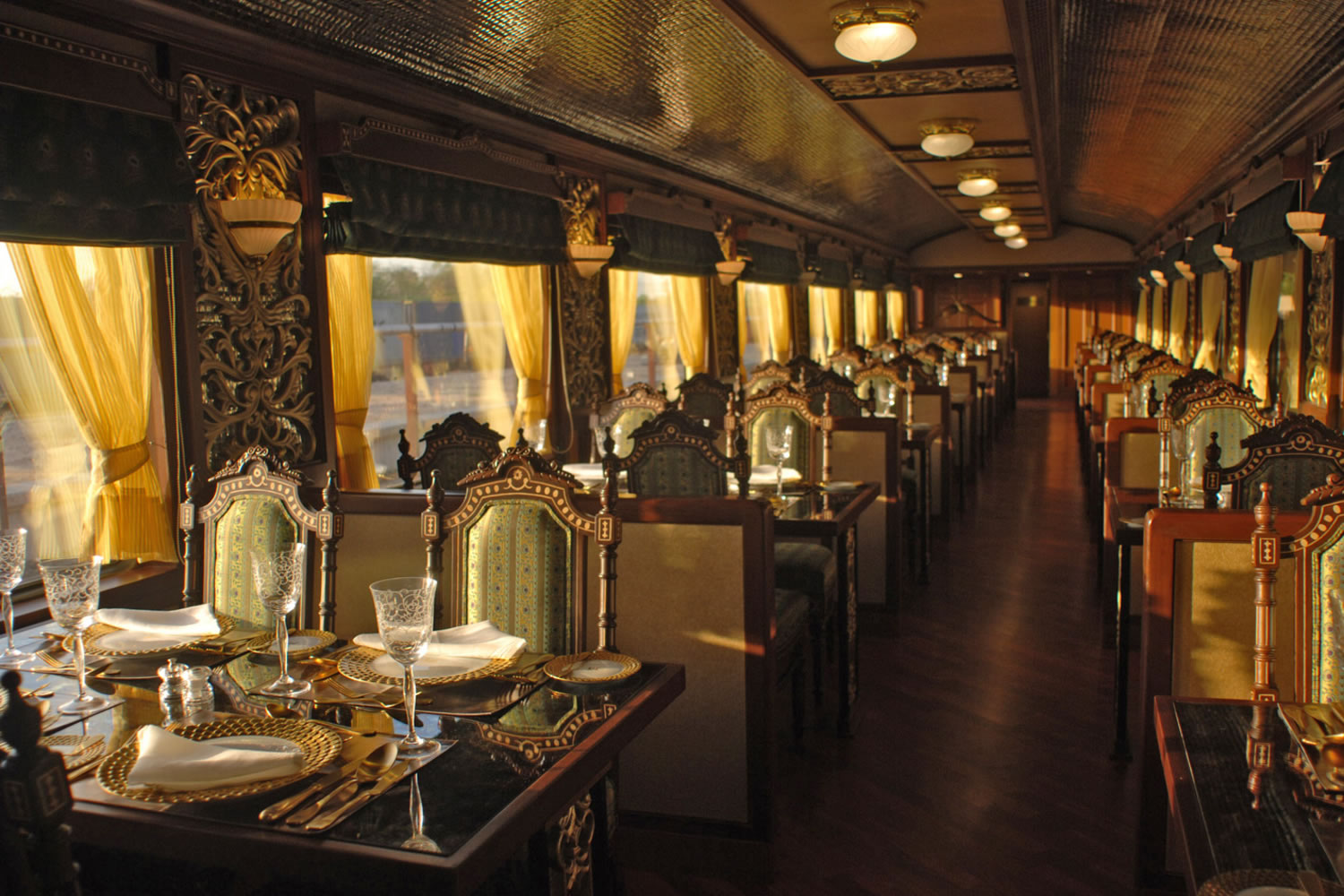
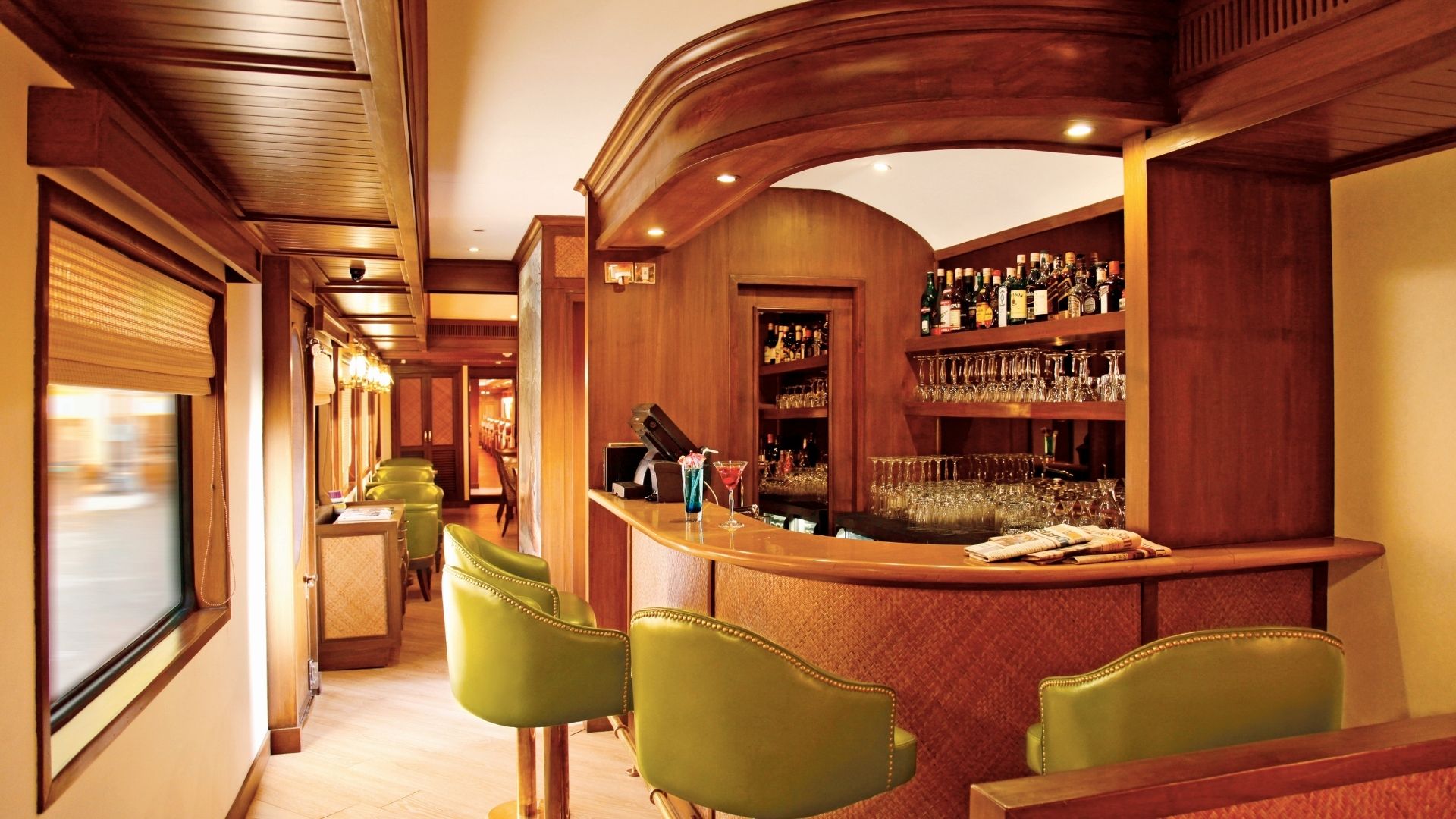
24. Palace On Wheels
The Palace on Wheels is a luxury tourist train. 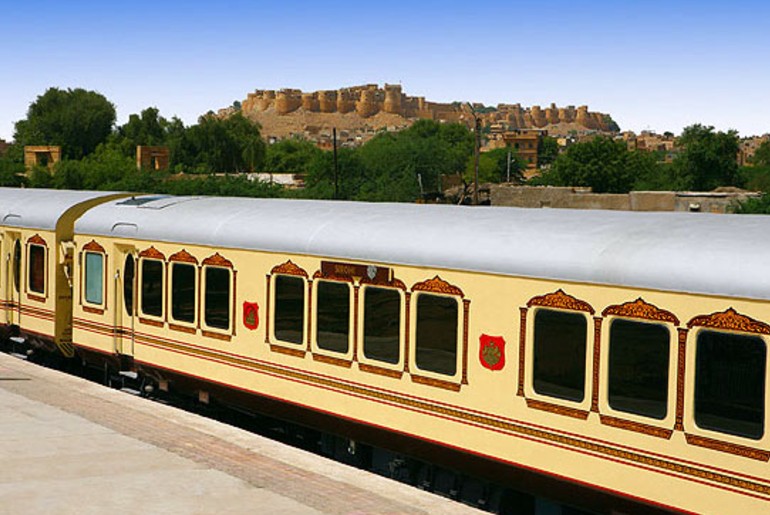 It was launched by the Indian Railways in association with Rajasthan Tourism Development Corporation to promote tourism in Rajasthan.[1] It is now known as Heritage Palace on Wheels. The train service was refurbished and relaunched in August 2009 with a new decor, itinerary and cuisine. The concept of the Palace on Wheels was derived from the royal background of the coaches, which were originally meant to be the personal railway coaches of the erstwhile rulers of the princely states of Rajputana, Baroda, the Nizam of Hyderabad and mainly the Viceroy of British India. Each saloon highlights the cultural ethos of the state, represented through the use of furniture, handicrafts, painting and furnishings. Jaipur-based Architect Rashmi Gupta did the interiors of the train. There are 23 coaches in the train. 104 tourists can travel in train. Each coach is named after former Rajput states and matches the aesthetics and interiors of the royal past: Alwar, Bharatpur, Bikaner, Bundi, Dholpur, Dungargarh, Jaisalmer, Jaipur, Jhalawar, Jodhpur, Kishangarh, Kota, Sirohi and Udaipur.[7] Each coach has four cabins (named chambers or saloons by the company) with luxury amenities and Wi-Fi internet.[8][9] The train has two restaurants, The Mahārāja and The Mahārāni, with a Rajasthani ambience serving continental, Chinese cuisine, one bar-cum-lounge, 14 saloons and a spa.[9] The train has a 7 nights & 8 days itinerary departs from New Delhi (Day 1), and covers Jaipur (Day 2), Sawai Madhopur and Chittaurgarh (Day 3), Udaipur (Day 4), Jaisalmer (Day 5), Jodhpur (Day 6), Bharatpur and Agra (Day 7), return to New Delhi (Day 8).[10]
It was launched by the Indian Railways in association with Rajasthan Tourism Development Corporation to promote tourism in Rajasthan.[1] It is now known as Heritage Palace on Wheels. The train service was refurbished and relaunched in August 2009 with a new decor, itinerary and cuisine. The concept of the Palace on Wheels was derived from the royal background of the coaches, which were originally meant to be the personal railway coaches of the erstwhile rulers of the princely states of Rajputana, Baroda, the Nizam of Hyderabad and mainly the Viceroy of British India. Each saloon highlights the cultural ethos of the state, represented through the use of furniture, handicrafts, painting and furnishings. Jaipur-based Architect Rashmi Gupta did the interiors of the train. There are 23 coaches in the train. 104 tourists can travel in train. Each coach is named after former Rajput states and matches the aesthetics and interiors of the royal past: Alwar, Bharatpur, Bikaner, Bundi, Dholpur, Dungargarh, Jaisalmer, Jaipur, Jhalawar, Jodhpur, Kishangarh, Kota, Sirohi and Udaipur.[7] Each coach has four cabins (named chambers or saloons by the company) with luxury amenities and Wi-Fi internet.[8][9] The train has two restaurants, The Mahārāja and The Mahārāni, with a Rajasthani ambience serving continental, Chinese cuisine, one bar-cum-lounge, 14 saloons and a spa.[9] The train has a 7 nights & 8 days itinerary departs from New Delhi (Day 1), and covers Jaipur (Day 2), Sawai Madhopur and Chittaurgarh (Day 3), Udaipur (Day 4), Jaisalmer (Day 5), Jodhpur (Day 6), Bharatpur and Agra (Day 7), return to New Delhi (Day 8).[10]
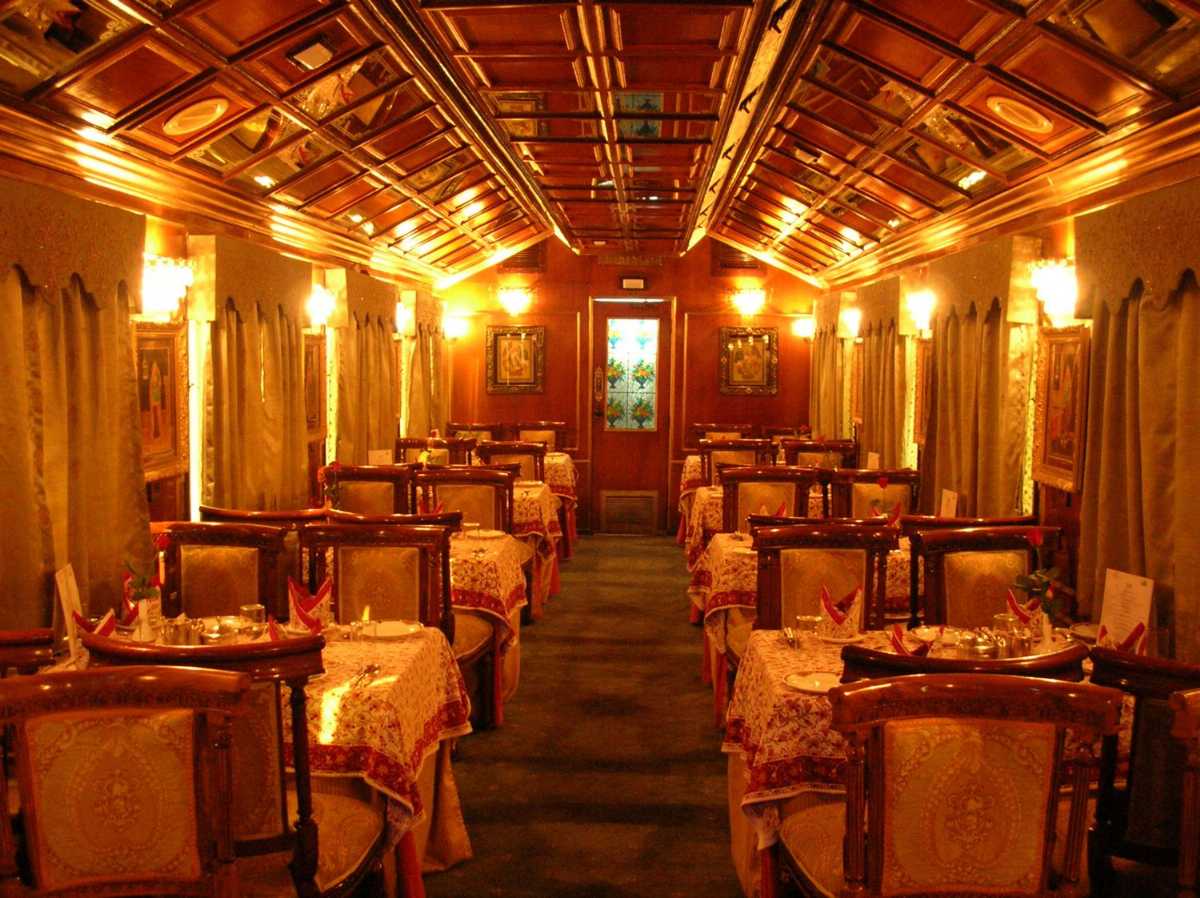


25. Deccan Odeyssey
The Deccan Odyssey is an Indian luxury .jpg) train modeled on the Palace on Wheels and put into service to boost tourism on the Maharashtra route of the Indian Railways. The train, owned by travel company Cox & Kings since 2014, takes visitors on a variety of seven night, eight day trips across Maharashtra. The Deccan Odyssey was devised by Indian Railways and the Maharashtra Tourism Development Corp in 2001 in an effort to increase tourism in Maharashtra. Integral Coach Factory started construction in 2002 and finished in 2003. The first trip departed on 16 January 2004 for a week-long maiden trip and was flagged off by Prime Minister Vajpayee. The train was not in service for the majority of the COVID-19 pandemic and is expected to start running again in October 2022. The train has 21 coaches, each named after places in Maharashtra and can accommodate up to 88 passengers.[14][2] Suite amenities include an en suite bathroom, Wi-Fi, a TV, and a cell phone "with all emergency numbers fed in."[15] Guests are serviced by an onboard butler and each suite is marked with a custom nameplate.[16] In addition to accommodation amenities, the train is fully air-conditioned and has a small gym, a spa, salon, library, foreign exchange services, a bar, and a conference room, which can be converted into a dance floor. Waavar and Utsav, the restaurants on board, are managed by Taj Hotels. The Deccan Odyssey offers six different seven day, eight night trips around Maharashtra, typically starting and ending in Mumbai at Chhatrapati Shivaji Terminus with the exception of the Indian Odyssey journey, which starts in New Delhi and ends in Mumbai, and the Indian Sojourn journey, which starts in Mumbai and ends in Delhi.[17][2][15][5][13] Guests can adhere to pre-arranged sightseeing tours or explore each stop on their own. Trips typically run between October and May. The Deccan Odyssey has won the title of Asia's Leading Luxury Train at the World Travel Awards in 2010-2012, 2014, and 2015-2019. It was also named World's Leading Luxury Train in 2019.
train modeled on the Palace on Wheels and put into service to boost tourism on the Maharashtra route of the Indian Railways. The train, owned by travel company Cox & Kings since 2014, takes visitors on a variety of seven night, eight day trips across Maharashtra. The Deccan Odyssey was devised by Indian Railways and the Maharashtra Tourism Development Corp in 2001 in an effort to increase tourism in Maharashtra. Integral Coach Factory started construction in 2002 and finished in 2003. The first trip departed on 16 January 2004 for a week-long maiden trip and was flagged off by Prime Minister Vajpayee. The train was not in service for the majority of the COVID-19 pandemic and is expected to start running again in October 2022. The train has 21 coaches, each named after places in Maharashtra and can accommodate up to 88 passengers.[14][2] Suite amenities include an en suite bathroom, Wi-Fi, a TV, and a cell phone "with all emergency numbers fed in."[15] Guests are serviced by an onboard butler and each suite is marked with a custom nameplate.[16] In addition to accommodation amenities, the train is fully air-conditioned and has a small gym, a spa, salon, library, foreign exchange services, a bar, and a conference room, which can be converted into a dance floor. Waavar and Utsav, the restaurants on board, are managed by Taj Hotels. The Deccan Odyssey offers six different seven day, eight night trips around Maharashtra, typically starting and ending in Mumbai at Chhatrapati Shivaji Terminus with the exception of the Indian Odyssey journey, which starts in New Delhi and ends in Mumbai, and the Indian Sojourn journey, which starts in Mumbai and ends in Delhi.[17][2][15][5][13] Guests can adhere to pre-arranged sightseeing tours or explore each stop on their own. Trips typically run between October and May. The Deccan Odyssey has won the title of Asia's Leading Luxury Train at the World Travel Awards in 2010-2012, 2014, and 2015-2019. It was also named World's Leading Luxury Train in 2019.

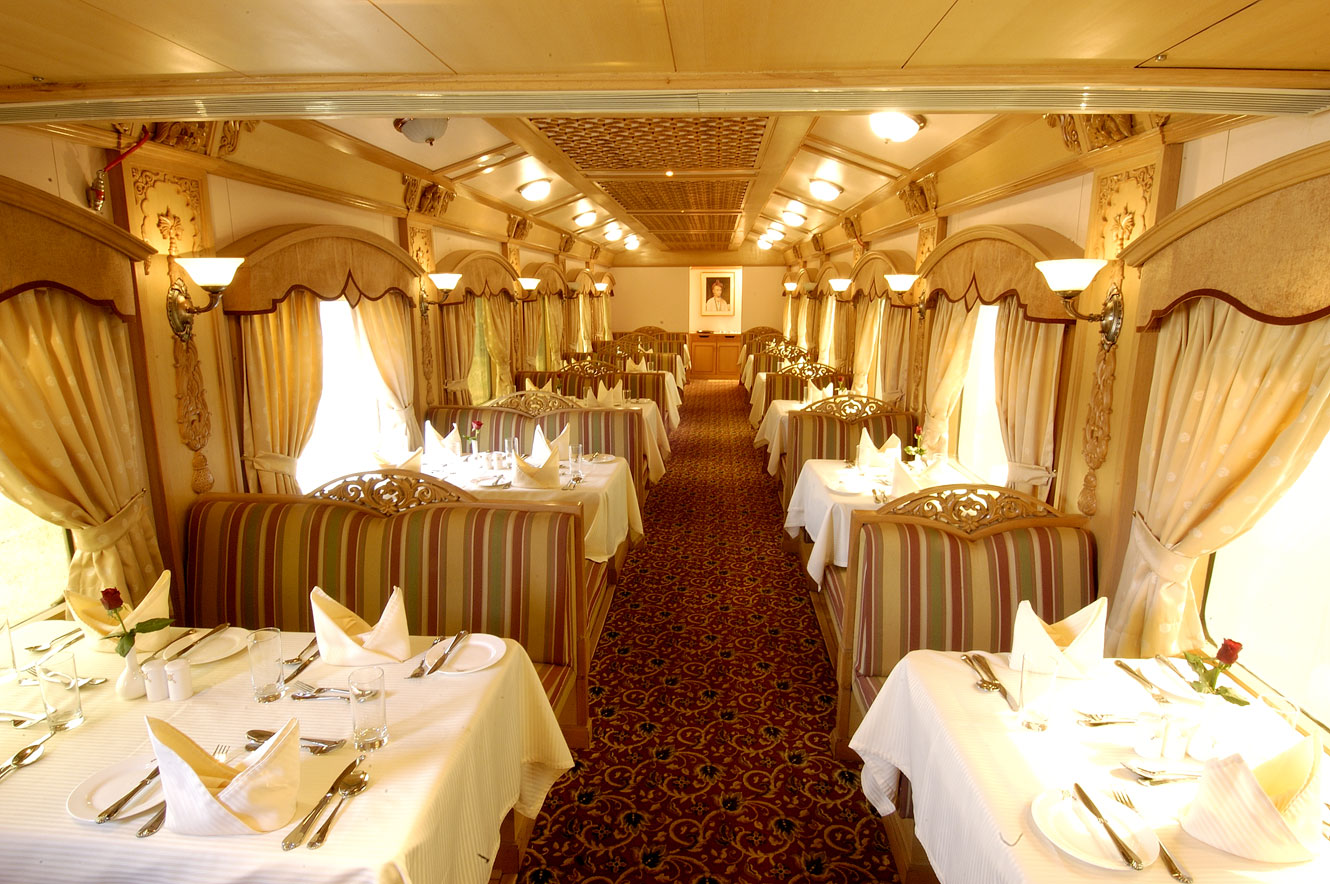
26. Passenger Trains
The Slow and fast passenger trains are passenger train services  of Indian Railways which connect small towns and cities to metropolitan cities in India, which form the backbone of the economy and railways of India for future development.[1] The word Passenger states that it halts at all stations on the electrified and non-electrified railway routes. Currently, the total separate 3572 passenger trains are running of all railway zones of Indian Railways. The country's first passenger train from Western India, which ran between Bombay Bori Bunder station (now Chhatrapati Shivaji Terminus) and Thane on 16 April 1853, was dedicated by Lord Dalhousie. The 14-carriage train was hauled by three steam locomotives: the Sahib, Sindh, and Sultan. Travelling 34 kilometres (21 mi), the train carried 400 people. Slow passenger trains are slow ordinary passenger trains in India. They stop at every station on the route, except abandoned ones. Fast passenger trains are fast ordinary passenger trains in India. They skip some stops on the route, mostly less-booked ones. Diesel Electric Multiple Unit (DEMU) are also comes in passenger trains of India. Stops at every station of the electrified and non-electrified route. Mainline Electric Multiple Unit (MEMU) also comes in passenger trains of India. Stops at every station only of the electrified route for connecting suburban and rural areas. All the coaches are unreserved.
of Indian Railways which connect small towns and cities to metropolitan cities in India, which form the backbone of the economy and railways of India for future development.[1] The word Passenger states that it halts at all stations on the electrified and non-electrified railway routes. Currently, the total separate 3572 passenger trains are running of all railway zones of Indian Railways. The country's first passenger train from Western India, which ran between Bombay Bori Bunder station (now Chhatrapati Shivaji Terminus) and Thane on 16 April 1853, was dedicated by Lord Dalhousie. The 14-carriage train was hauled by three steam locomotives: the Sahib, Sindh, and Sultan. Travelling 34 kilometres (21 mi), the train carried 400 people. Slow passenger trains are slow ordinary passenger trains in India. They stop at every station on the route, except abandoned ones. Fast passenger trains are fast ordinary passenger trains in India. They skip some stops on the route, mostly less-booked ones. Diesel Electric Multiple Unit (DEMU) are also comes in passenger trains of India. Stops at every station of the electrified and non-electrified route. Mainline Electric Multiple Unit (MEMU) also comes in passenger trains of India. Stops at every station only of the electrified route for connecting suburban and rural areas. All the coaches are unreserved.


